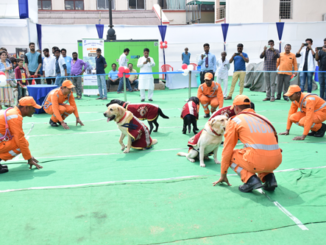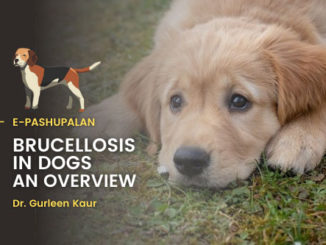Introduction
Canine babesiosis is a serious disease among tick-borne haemoprotozoan diseases, globally. Canine babesiosis can range from chronic or subclinical to peracute and fatal, depending on the virulence of the species and the susceptibility of the host. These protozoa are classified as either large (e.g., Babesia canis) or small (e.g., Babesia gibsoni) (S. Yogeshpriya et al 2014). Babesiosis is the diseased state caused by the protozoal (single celled) parasites of the genus Babesia. Infection in a dog may occur by tick transmission, direct transmission via blood transfer from dog bites, blood transfusions, or transplacental transmission. This paper describes a case of canine babesiosis in a dog.
Case History
Blood sample from a male Rottweiler dog aged 5 years was presented at the Disease Investigation Laboratory, Rudrapur, U S Nagar, Uttarakhand, India with the history of acute bilateral blindness, staggering gait, fever, weakness, inappetance. On clinical examination, the animal had temperature of 104.5, pallor conjunctival and oral mucus membranes and loss of pupillary light reflexes were identified. Dog was affected with tick infestation. Dog also had a history of being infected with Babesiosis in the past.
Laboratory Findings
Following sample collection, a thin blood smear was prepared with Giemsa staining for haematological evaluation. On wet film examination, no moving parasites could be detected. On microscopic examination stained blood smear revealed small, single, signet ring and tear shaped pyriform trophozoites of the parasite in erythrocytes confirmed as babesiosis. Haematological investigation revealed haemoglobin 8.0 gm%.

Treatment
First and foremost is imidocarb dipropionate @ 5.0 to 6.6 mg/kg IM or SC, repeated in 2 weeks to treat clinical disease, Prophylactic use of oral doxycycline (5 to 20 mg/kg/day) (Amy, 2001) has been suggested in dogs. It was given for 15 days. Prednisolone was given orally at a daily dose of 2 mg/kg, for 4 days. Also supportive therapy was given with intramuscular administration of IntavitaH 3 ml for 5 days. An eye drop NAC (Sodium carboxymethyl) was also prescribed for 25 days. Dog recovered successfully after a span of 25 days treatment. But after 6-7 months, again Dog got infected with blood protozoa Babesia and showed similar symptoms. This time he could not recover due to repeated infection and finally succumbed to death.
Conclusion
To our knowledge ocular involvement in canine babesiosis is rarely reported in India and a matter of further study.
References
- Amy, C.K. (2001). Compend.23: 4.
- Yogeshpriya et al. (2014). ISSN : 2321-6387
| The content of the articles is accurate and true to the best of the author’s knowledge. It is not meant to substitute for diagnosis, prognosis, treatment, prescription, or formal and individualized advice from a veterinary medical professional. Animals exhibiting signs and symptoms of distress should be seen by a veterinarian immediately. |
How useful was this post?
Click on a star to review this post!
Average Rating 4 ⭐ (123 Review)
No review so far! Be the first to review this post.
We are sorry that this post was not useful for you !
Let us improve this post !
Tell us how we can improve this post?
Authors
-

Disease Investigation Laboratory, Rudrapur, U S Nagar, Department of Animal Husbandry, Uttarakhand
-

Disease Investigation Laboratory, Rudrapur, U S Nagar, Department of Animal Husbandry, Uttarakhand
-

Disease Investigation Laboratory, Rudrapur, U S Nagar, Department of Animal Husbandry, Uttarakhand
-

Disease Investigation Laboratory, Rudrapur, U S Nagar, Department of Animal Husbandry, Uttarakhand





Be the first to comment